Journal of Ergonomics
Open Access
ISSN: 2165-7556
ISSN: 2165-7556
Research Article - (2022)Volume 12, Issue 6
Sea water is a hostile environment in a multitude of ways. Cold water can quickly put the human diver into hypothermia leading to organ damage, loss of consciousness, and ultimately death. Hence, thermal protection is critical. It is usually provided by conventional neoprene wetsuits. However, neoprene loses thermal insulation with depth, as its air bubbles shrink under increasing ambient pressure. Thicker neoprene improves protection but is far less flexible, which worsens ergonomics and fatigues the diver faster. We recently developed and reported on a segmented composite suit (K1) that presented a solution to these problems. The suit uses a composite material containing silicone-embedded hollow glass microspheres. As the glass microspheres do not shrink with depth, the K1 suit offered thermal protection that was depth-independent and superior to a conventional 7 mm neoprene suit, while being as flexible as a 3 mm suit. However, the K1 suit produced large positive buoyancy, which necessitated the use of extra ballast, worsened the weight distribution, and increased the total inertial mass. Herein, we report on a new improved version of the suit (K2), which offers improved thermal protection, near neutral buoyancy, and superior ergonomics of weight distribution in comparison to K1, while retaining K1’s depth-independence and flexibility. K2 achieves these improvements by incorporating tandem segments made of a layer of hollow glass and a layer of solid ceramic microspheres. The improved K2 suit was field-tested against a variety of competing arrangements of commercial suit systems, by pair diving. The experimental results are presented herein. The K2 suit is an impactful step forward in diver suit development and should be of great interest to military, commercial, and recreational divers.
Microspheres; Neoprene suit; Recreational divers; Thermal protection
One of the major health hazards of diving is heat loss, as sea water has 4 times the specific heat capacity and 24 times the thermal conductivity compared to air [1]. Consequently, as the same temperature difference between body and water, highly adapted sea mammals lose heat 4.5 times faster in water than in air [2,3]. That heat loss leads to hypothermia happening far more rapidly with human divers. After one hour in 10°C water, or quarter hour in 5°C water, a human diver’s core temperature would fall below 35.5°C and the diver would enter hypothermia. That puts him at risk of organ damage and loss of consciousness, and if the condition persists, death. Extensive training and physical conditioning can help to some extent but cannot completely compensate for the heat loss. Consequently, thermal protection is indispensable, especially during long dives and in colder waters [4-7].
Standard thermal protection for divers is provided by equipping a wetsuit. The wetsuit is tailored from sheets of fabric material produced by sandwiching a 3 mm-8 mm bubbled neoprene layer between two cloth layers (typically 0.2 mm thick each). The microscopic air pockets trapped in bubbled neoprene make it spongy, and thus thermally insulative and flexible. For a lean diver in 5°C water, a 3 mm suit would extend the time to hypothermia from 15 minutes to 1 hour, while a 5 mm suit would extend it to 1.5 hours [6]. It makes sense then to make thicker suits for more protection. However, thicker neoprene is significantly less flexible, which hampers motion and fatigues the diver. As a result, neoprene wetsuit thickness is typically no more than 7 mm-8 mm. In addition, thicker neoprene produces larger fluctuations with depth in the amount of ballast the diver needs to add to achieve neutral buoyancy. For example, a 3 mm wetsuit requires approximately 2 kg at the surface and 1 kg at depth, while a 7 mm wetsuit requires approximately 6 kg ballast at the surface and 2 kg at depth. Having to adjust buoyancy continually through the BCD and by a significant margin distracts the diver from his primary tasks and wastes breathing gas, shortening the available dive time. Overall, a 7 mm suit incurs a significant loss of ergonomics compared to 3 mm suit.
In addition, the compressibility of the air pockets means that the bubbled neoprene shrinks significantly with ambient pressure. Hence, its thermal insulation rapidly degrades with depth [8]. Our own measurements [9] of 8 mm neoprene from a commercial dive suit showed ~50% loss of thermal insulance at 30 msw, compared to sea level. To solve the shrinkage problem, we developed a composite material containing hollow glass microspheres embedded in silicone carrier polymer and experimentally showed that the material had thermal insulance that was retained with depth and was superior to the one of bubbled neoprene of the same starting thickness. Next, we used the composite to build a diver suit prototype (K-suit, or K1 for short) [9,10].
Since the composite material was less flexible than neoprene, and flexibility is required for ergonomics, the composite plates were segmented along the major joints of the body to allow the suit to bend easily where needed. The areas that do not bend (e.g. lower leg, upper leg, torso) were protected by thick monolithic composite plates cast from molds. The molds were 3D-printed in polycarbonate, using designs made by digitally segmenting a 3D scan of the body of the diver. The composite plates were attached to a 3 mm neoprene undersuit by enclosing them in neoprene pockets glued to the outside of the undersuit. As a result, K1 suit had the effective flexibility of a 3 mm suit, while its thermal protection exceeded the one of a 7 mm commercial neoprene suit, as demonstrated by direct comparison in tandem diving field tests [10].
While highly successful in flexibility and thermal protection, the K1 suit worsened some ergonomics problems. As the effective density of the saturated composite[9] was ~500 kg/m3, i.e. half the density of water, the K1 suit generated very significant positive buoyancy. To compensate, the diver must increase the carried load of ballast, which increases the total inertial mass. It also worsens the weight distribution and underwater balance, as the extra ballast is typically concentrated around the midsection of the diver.
As most of the plating is in the torso and upper body, this further heightens the Center of Mass (CM) of the displaced water, while the CM of the diver remains around the belt height. This produces a larger torque around the diver’s CM, which tries to position the body of the diver vertically. Divers are trained to compensate for this effect by producing a torque through vigorous kicking, but that wastes more energy and adds further fatigue. These phenomena lead us to the idea of a neutrally buoyant suit. If some of the hollow glass microspheres (density ~125 kg/m3) were replaced with solid ceramic microspheres (density ~2,300 kg/m3), it would be possible for the overall suit to approach neutral buoyancy. We built the new K2 suit using the same techniques as used with the K1, with the major difference being that each new composite plate was made of two plates, one of which had hollow glass microspheres embedded as before, but the other had embedded solid ceramic microspheres. Each pair of plates was contained in its own pocket externally glued onto the 3 mm neoprene undersuit. K2 proved to be close to neutrally buoyant, as flexible as a 3 mm neoprene, and with superior weight distribution ergonomics.
Thermal field tests were conducted by tandem diving to compare the K2 to a variety of commercial neoprene systems. The results showed that in terms of thermal protection, the K2 is significantly better than a 5 mm neoprene suit, and better than a 7 mm suit, particularly at depth, as K2 retained thermal protection at depth. Overall, K2 is a significant important improvement over K1, particularly in ergonomics, but also in thermal protection. The K2 suit should be of major interest to the commercial, military, and recreational diving communities.
IRB approval
Field test plans for the project were reviewed and approved by the Institutional Review Board (IRB) at the Naval Postgraduate School (NPS).
Body scans, designs, and molds
The original body scans[10] were used to design upper arm, lower arm, and shin segments, by the same software process[10]. Corresponding molds were 3D printed in polycarbonate using a Fortus 400 mc 3D printer (Stratasys, Eden Prairie, MN, USA). The new molds and the existing molds were then used to cast the hollow glass composite segments.
Composite segments
Sylgard 184 (Dow Corning, Midland, MI, USA) prepolymer was mixed with K1 hollow glass microspheres (3M Corp.) in a planetary mixer (ARE310,THINKY, Japan) for 4 min at 1500 rpm, and cured in the molds in a Forced Air Oven (VWR) at 80°C for 2 hours. The casts were extracted from the molds, deflashed, and trimmed to best fit Diver A. Separately, Sylgard 184 (Dow Corning, Midland, MI, USA) prepolymer was mixed with W610 solid ceramic microspheres (3M Corp.) in a planetary mixer (ARE310, THINKY, Japan) for 4 min at 1500 rpm, poured in aluminum trays to an approximate thickness of 3 mm, and cured in the trays in a Forced Air Oven (VWR) at 80°C for 2 hours. The ceramic composite was removed from the trays and cut to size to match the corresponding cast glass composite segments.
Suit assembly
3D-printed polycarbonate molds (Figure 1 A) were used to cast and thermally cure hollow glass microspheres composite segments (Figure 1 B). The segments (Figure 1 C) were deflashed, trimmed to maximize fit, and organized with matching solid ceramic microsphere composite cutouts (Figure 1 D). Then the composite segments were fitted and traced onto a 3 mm fitted undersuit worn by Diver A. Thin neoprene pieces were cut to match the tracings, with an added margin of 1 inch. Then each trio (matching glass, ceramic, and neoprene segment) was assembled onto the outside of the undersuit at its corresponding location and glued in place using neoprene cement on the added margin of the thin neoprene segment. This completed the K2 suit (Figures 1F and 1G).”
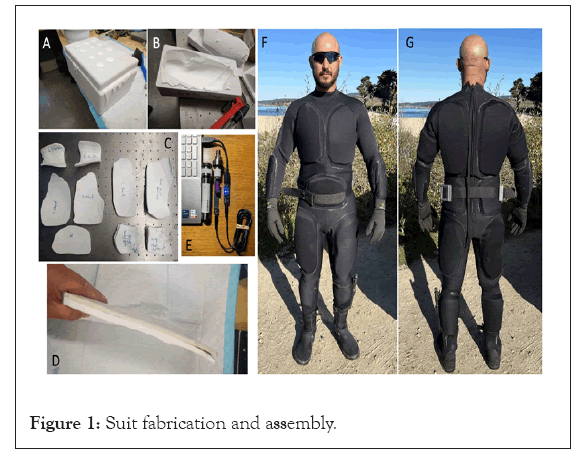
Figure 1: Suit fabrication and assembly.
Biometric data
For each diver participating in the field tests, biometric data was collected using ES-26M-W Smart Body Analyzer (FITINDEX, fit-index.com). The results were anonymized in compliance with HIPAA regulations. The anonymized biometrics are presented in Table 1.
| Gender | Diver A | Diver C | Diver E | Diver F |
|---|---|---|---|---|
| Male | Male | Male | Male | |
| Height, cm | 165 | 184 | 180 | 185 |
| Weight, kg | 76.6 | 92.75 | 86.95 | 129.4 |
| Age, yr | 38 | 30 | 29 | 26 |
| Metabolic Age, yr | 41 | 32 | 30 | 32 |
| BMI, kg/m2 | 28.1 | 27.4 | 26.8 | 37.8 |
| Body Fat, wt% | 23.8 | 21.9 | 20.9 | 37.2 |
| Fat-free Body Weight, kg | 58.4 | 72.5 | 68.8 | 81.2 |
| Subcutaneous Fat, wt% | 20.6 | 18.9 | 18 | 31.5 |
Table 1: Biometric data for divers.
Field testing
The field test dives were conducted in Monterey Bay, California. The shallow dives were done in the breakwater by San Carlos Beach, while the deeper dives were done in the Carmel River and Monastery Beach. In each dive, Diver A wore the K2 suit, while the second diver (C, E, and F) was another person in a commercial dive suit. In each dive, the two divers maintained the same depth and close proximity (<0.9 m), including swimming hand-in-hand in poor visibility and swift currents. Different dives tested K2 against different arrangements of commercial systems. OM-CP- PRTEMP1000 data loggers (Omega Engineering, Norwalk, CT) were used to record the pressure and temperature digitally and automatically. Each diver wore a logger under his suit at the breastbone. Diver A also wore an additional logger inside his BCD (Buoyancy Control Device) mesh, to record the ambient water temperature. After each dive, the dataloggers were opened and connected to a computer (Figure 1 E) to download the temperature and pressure data digitally recorded during the dive.
The preceding version (K1) of the K-suit offered improved thermal protection coupled with superior flexibility, when compared with commercial 7 mm neoprene suits [10]. However, it also had significant positive buoyancy as the composite effective density [9] was ~500 kg/m3. The positive buoyancy meant the diver needed to compensate for it by increasing the carried load of ballast. That increased the overall inertial mass, slowing the diver down, while the ballast carried around the waste also worsened the weight distribution of the diver. These issues led us to the idea of improving the K-suit by changing the content of the composite in such a way that its effective density approaches neutral density. This would result in far less of an excess buoyancy, which would mean that the ballast load could be minimized. Less ballast and mass more distributed across the body of the diver meant superior weight distribution and less overall inertial mass. The added mass was simultaneously utilized to add further thermal insulation, making the suit more thermally protective as well.
We noted that neutral density could be achieved by replacing some percentage of the hollow glass microspheres (density ~125 kg/m3) in the effective composite plate, with solid ceramic microspheres (density ~2,400 kg/m3). At ~50% volumetric concentration [9] inside Sylgard 184 silicone, the resulting effective densities of the composites would be ~500 kg/m3 with hollow glass and ~1,700 kg/m3 with solid ceramic. The casting molds would produce a thickness of ~7 mm, so if we allowed for the same area but 7 mm thickness for the hollow glass composite and 4 mm thickness of the solid ceramic composite, the resulting density of the overall layered plate segment would be (7*500+4*1700)/(7+4)~940 kg/ m3, i.e. approaching neutral buoyancy.
To accomplish this plan, all the molds from the K1 suit were reused. The same process as before was used to convert body scans into designs for composite segments for the lower arm, upper arm, and shins. Respective molds were designed and 3D-printed in polycarbonate. Hollow glass K1 microspheres were embedded in silicone, thermally cured in the molds, extracted, deflashed, and trimmed down to fit Diver A [10]. Next, solid ceramic W610 microspheres were embedded in silicone, poured into ~3 mm-4 mm sheets in baking trays, thermally cured, peeled off, and trimmed to fit the corresponding cast glass composite segments. The two-layer segments were then fitted onto a 3 mm neoprene suit worn by Diver A and secured by thin neoprene pockets that were glued to the suit externally using neoprene cement. The result was the K2 suit.
The K2 suit was field-tested by Diver A diving in pairs with other divers wearing different arrangements of commercial suits. The anonymized diver biometrics are listed in Table 1. The goal was to test the performance of the suit in the cold waters of Monterey Bay by recording the internal and external temperatures for both divers. Automated dataloggers were used to digitally record the temperature and the pressure. Diver A wore a logger inside the suit over the sternum and a second logger inside the meshing of the Buoyancy Control Device (BCD). The second diver in each dive wore a logger inside the suit over the sternum. After each dive was completed, the loggers were opened and connected to a computer to download the recorded data (Figure 1 E).
To determine the performance of the K2 suit, we established four criteria: thermal protection, ergonomics of flexibility, ergonomics of weight distribution, and depth independence. The K2 suit outperformed all contestants in flexibility (due to being 3 mm thick at the joints) and weight distribution (due to being close to neutrally buoyant). K2 also demonstrated less susceptibility to thermal performance degradation with depth than the neoprene systems. However, the K2 comparative thermal protection performance was only better than some but worse than others.
In Dive Test #1, the second diver, Diver F, wore a commercial 5 mm neoprene suit. The results (Figure 2) show a significant advantage of the K2 suit in thermal protection, wherein the K2 was ~5°C warmer than the 5 mm neoprene suit, while also offering neutral buoyancy and better flexibility (equivalent to 3 mm). So, K2 outperformed the 5 mm commercial suit in both ergonomics and thermal protection.
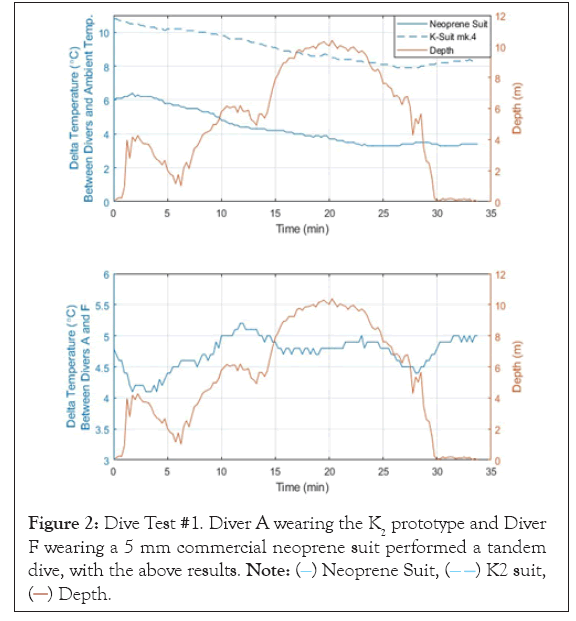
Figure 2: Dive Test #1. Diver A wearing the K2 prototype and Diver F wearing a 5 mm commercial neoprene suit performed a tandem dive, with the above results.

In Dive Test #2, the second diver, Diver E, wore a commercial 7 mm neoprene suit. The results show a thermal advantage of the K2 suit, particularly at depth of 10 m and beyond, wherein the K2 was ~1°C warmer. Conversely, the 7 mm had about the same advantage at and near zero depth. This demonstrates that the K2 is less affected by depth than the neoprene, matching expectations. The overall results suggest that the two suits are roughly equivalent in terms of thermal protection at small depths. However, the K2 suit was shown to be less affected by increased depth and should be preferable especially for longer exposure to greater depths.
In Dive Test #3, the second diver, Diver C, wore a 7 mm BARE suit and a 3 mm neoprene sleeveless vest under it. The results (Figure 3) indicate a significant advantage for the 7+3 system, but that advantage decreased from 5.5°C to 4.5°C with duration of the dive at significant depth. In particular, the individual data showed that K2 maintained temperature difference with the environment for about 40 min at 10 m depth, while the second diver’s delta worsened by 1°C over the same period. This demonstrates that the K2’s thermal protection is less affected by depth, as expected.
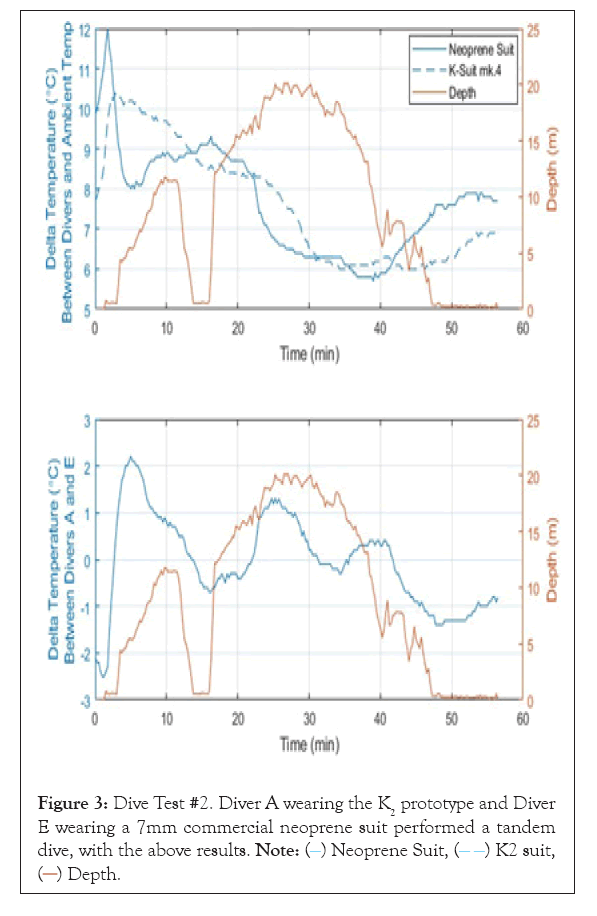
Figure 3: Dive Test #2. Diver A wearing the K2 prototype and Diver E wearing a 7mm commercial neoprene suit performed a tandem dive, with the above results.

In Dive Test #4, the second diver, Diver E, wore a two-layer commercial suit composed of a 7 mm neoprene sleeveless “Long-John” extending to the shoulders, and a 7 mm neoprene jacket covering the arms and extending down to the upper thighs. The result was an effective 14 mm neoprene thickness consistently across the torso. The results (Figure 5) indicate a large thermal advantage to the 14 mm system, but that advantage lessened by 1.5°C over time spent at depth. This demonstrates that the K2 was less affected by depth. K2 also retained the ergonomic advantages of neutral buoyancy and better flexibility (equivalent to 3 mm).
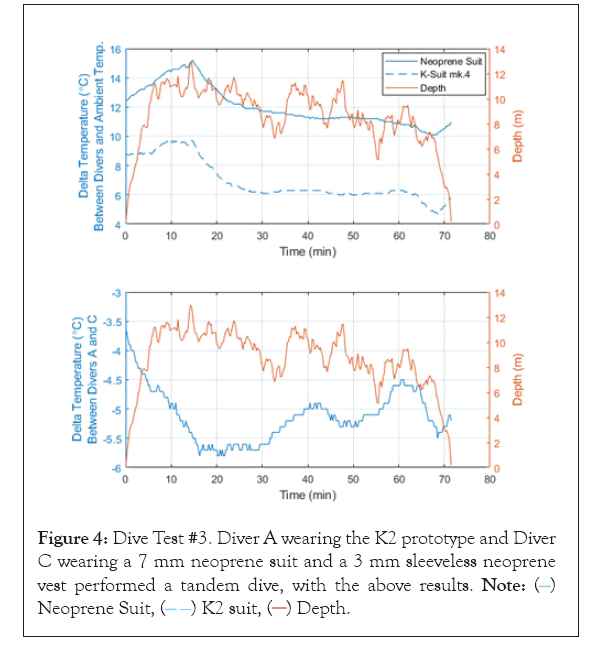
Figure 4: Dive Test #3. Diver A wearing the K2 prototype and Diver
C wearing a 7 mm neoprene suit and a 3 mm sleeveless neoprene
vest performed a tandem dive, with the above results. 

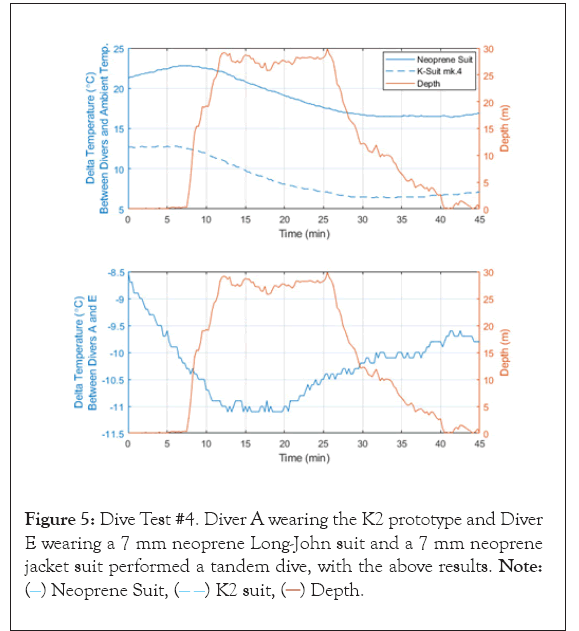
Figure 5: Dive Test #4. Diver A wearing the K2 prototype and Diver E wearing a 7 mm neoprene Long-John suit and a 7 mm neoprene jacket suit performed a tandem dive, with the above results. Note:
Perhap the best way to compare the K2 with the K1 in terms of thermal protection is to compare the internal temperatures for the divers. The K1 showed temperature difference [9] of 10.5 °C with respect to the ambient water at up to 6 m of depth. The K2 demonstrated temperature difference of ~9°C at up to 10 m of depth. However, oceanographic surveys (www.seatemperature. org) indicate that the water temperature is 14°C during the summer but 12°C during the winter. Since K1 was tested during the summer, while K2 was tested during the winter, the inside temperature of the K2 suit was therefore ~0.5°C higher than that of the K1 suit. Hence, K2 provided better thermal protection than K1.
The experimental results suggest that the K2 suit is an excellent balanced solution for applications where both good ergonomics and thermal protection are required. K2 outperforms the 5 mm neoprene system handily by both criteria. K2 outperforms K1 in both criteria as well. K2 is roughly equivalent in thermal protection but better at depth and significantly better ergonomically than the 7 mm neoprene suit. The K2 loses in thermal protection to very thick systems (7+3 and 7+7 mm), but that disadvantage decreases with increasing depth, while K2 is markedly more ergonomic.
In future work, it should be worthwhile to design a helmet using the same composite approach, as significant heat loss occurs through the head. While Diver A wore a 3 mm thin neoprene hood to have at least some head protection, a measurable improvement in thermal performance ought to be expected from a full composite helmet. The same can be done similarly for hands and feet. As another improvement, a somewhat thicker suit can be designed to use a 5 mm neoprene instead of 3 mm, as the base of the suit. That would improve protection in the areas where there was no composite, thereby potentially reducing a significant source of heat loss. The change would worsen the ergonomics of flexibility by some amount, but that would still be superior to a 7 mm suit and its thicker combinations, while the thermal protection might improve by a larger margin. Finally, better tailoring would produce a tighter fit to the body of the diver, reducing the volume of the water trapped between the wetsuit and the skin of the diver, and thus improving overall performance.
The K2 suit presented herein is a significant improvement of both ergonomics and thermal protection over its predecessor the K1 suit. The K2 is a field-tested balanced solution that offers the ergonomic flexibility of a 3 mm suit with thermal protection better than a 7 mm suit. In addition, the K2 offers near neutral buoyancy, superior weight distribution, and less dependence on depth, in comparison with neoprene suits. The K2 is a valuable new contribution to the options available to commercial, military, and recreational divers.
The authors thank Dan Sakoda at NPS for his help with the 3D printing. The authors thank all the divers involved in the field tests.
Funding for the work was provided from the Office of Naval Research through the NEPTUNE centre grant at NPS and through ONR grant N0001418GTC62271.
The authors have no conflicts of interest to declare regarding this manuscript and the work it describes.
[Cross Ref] [Google scholar] [Pub Med]
[Cross Ref] [Google scholar] [Pub Med]
Citation: Kartalov EP, Meligkaris K, Sabesky G, Catterlin J (2022) Neutrally Buoyant Ergonomic Segmented Cast Composite Diving Suit With Depth- Independent Thermal Protection. J Ergonomics.12:322
Received: 01-Dec-2022, Manuscript No. JER-22-20759; Editor assigned: 05-Dec-2022, Pre QC No. JER-22-20759 (PQ); Reviewed: 13-Dec-2022, QC No. JER-22-20759; Revised: 23-Dec-2022, Manuscript No. JER-22-20759; Published: 30-Dec-2022 , DOI: 10.35248/2165-7556.22.12.322
Copyright: © 2022 Kartalov EP, et al. This is an open-access article distributed under the terms of the Creative Commons Attribution License, which permits unrestricted use, distribution, and reproduction in any medium, provided the original author and source are credited.